 |
We've heard much about the importance of creating brand experiences, especially as it relates to shopping destinations. 'Experience' is the buzzword that describes that extra something that causes someone to chose one destination over another, other things being equal. Shopping center developers and their tenants who face shrinking sales realize their customers have cheaper and more efficient ways to purchase goods, like the Internet or the local Wal-Mart, so they've begun experimenting with 'experience' as a draw factor.
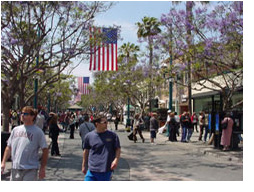 One of the more popular
solutions is the 'Main Street'
model, where the designs
echo romanticized town
squares. A recent example is
The Grove in Los Angeles, a
project that captures a small
town feel with a Disneyesque
execution. While efforts like
tthese are a step in the right
direction away from herme-
tically sealed malls, some of
these 'Main Streets' still have an artificial, sterile feel. Because most are designed and built all at once, they lack the sense of history that a naturally evolving community center has. Because the spaces tend to be 'secure', we don't see a lot of street people, itinerant craftsmen or freelance musicians. Because the developer 'edits' the experience, the result can be one-dimensional. The unbridled penchant to be 'messy' humans is gone. In the worst cases, it produces a prophylactic environment that fails to give us that full hit of the 'human experience' we crave as social animals. So how should property owners, developers and communities create viable and sustainable retail experiences? One of the more popular
solutions is the 'Main Street'
model, where the designs
echo romanticized town
squares. A recent example is
The Grove in Los Angeles, a
project that captures a small
town feel with a Disneyesque
execution. While efforts like
tthese are a step in the right
direction away from herme-
tically sealed malls, some of
these 'Main Streets' still have an artificial, sterile feel. Because most are designed and built all at once, they lack the sense of history that a naturally evolving community center has. Because the spaces tend to be 'secure', we don't see a lot of street people, itinerant craftsmen or freelance musicians. Because the developer 'edits' the experience, the result can be one-dimensional. The unbridled penchant to be 'messy' humans is gone. In the worst cases, it produces a prophylactic environment that fails to give us that full hit of the 'human experience' we crave as social animals. So how should property owners, developers and communities create viable and sustainable retail experiences?
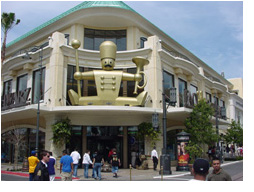 To start, I think it's important
to look at real thing - the real
Main Streets that large
property owners seek to
emulate. The Santa Monica
Third Street Promenade and
Seattle's Pike Place Market
are two that come to mind.
Both evolved naturally with
their diversity having been
preserved by a coalition of
property owners and local
government. The older buildings clash with the new in a pleasing jumble that gives us a sense of history. Cars, delivery vehicles, trash and smells that are a normal part of the urban commercial experience are not edited out of the picture. The mix of small shops, stands, street vendors and the nearby department stores all lend to a wonderful mish-mash of personal and corporate expression. And most importantly, there is no gatekeeper allowing certain people in and keeping certain people out. So long as the laws of civility are obeyed, all are welcome, and they all come. The suburban family in their Cadillac Escalade rubs shoulders with the homeless guy who just emerged from his appliance box home. Sure, there's the occasional fly in the soup, but the experience is rich and exciting. I like a little theater with my commerce, a preference I developed while studying a 2,000 year-old marketplace in Rome. To start, I think it's important
to look at real thing - the real
Main Streets that large
property owners seek to
emulate. The Santa Monica
Third Street Promenade and
Seattle's Pike Place Market
are two that come to mind.
Both evolved naturally with
their diversity having been
preserved by a coalition of
property owners and local
government. The older buildings clash with the new in a pleasing jumble that gives us a sense of history. Cars, delivery vehicles, trash and smells that are a normal part of the urban commercial experience are not edited out of the picture. The mix of small shops, stands, street vendors and the nearby department stores all lend to a wonderful mish-mash of personal and corporate expression. And most importantly, there is no gatekeeper allowing certain people in and keeping certain people out. So long as the laws of civility are obeyed, all are welcome, and they all come. The suburban family in their Cadillac Escalade rubs shoulders with the homeless guy who just emerged from his appliance box home. Sure, there's the occasional fly in the soup, but the experience is rich and exciting. I like a little theater with my commerce, a preference I developed while studying a 2,000 year-old marketplace in Rome.
Learning from Campo dei Fiori
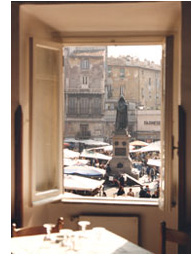 I arrived in Rome on a bright spring morning
in 1973. It was the beginning of my Rome
Studies Program sponsored by the
University of Washington School of
Architecture. And while I had lived in
Europe before, it was a big change for a
person raised in the suburbs of Seattle, like
me. So it was a further surprise to be
quartered in a wonderful little apartment
overlooking one of the most vibrant and
exciting urban spaces in the world. This
space is the piazza Campo dei Fiori, an
urban stage that traces its heritage back
to the time of Republican Rome. One of
the many nuggets of information* is that
this is the site of Julius Caesar's murder in 44 BCE. He was knifed in a small building adjoining the Theater of Pompey, an imposing structure that first established this area in the urban framework of Rome. That first day was a full one for me. Connecting with my fellow students and my Professoressa. Exploring the neighborhood. Getting a tour of my building and learning the house rules, one of which was to leave your shoes outside the front door at least once a week. This was so the old woman who lived on the ground floor could clean them, giving her a sense of usefulness and a little pocket money. As my only pair of college kid shoes were a little banged up, I left them outside the door on my first night. In the morning they were gone. I arrived in Rome on a bright spring morning
in 1973. It was the beginning of my Rome
Studies Program sponsored by the
University of Washington School of
Architecture. And while I had lived in
Europe before, it was a big change for a
person raised in the suburbs of Seattle, like
me. So it was a further surprise to be
quartered in a wonderful little apartment
overlooking one of the most vibrant and
exciting urban spaces in the world. This
space is the piazza Campo dei Fiori, an
urban stage that traces its heritage back
to the time of Republican Rome. One of
the many nuggets of information* is that
this is the site of Julius Caesar's murder in 44 BCE. He was knifed in a small building adjoining the Theater of Pompey, an imposing structure that first established this area in the urban framework of Rome. That first day was a full one for me. Connecting with my fellow students and my Professoressa. Exploring the neighborhood. Getting a tour of my building and learning the house rules, one of which was to leave your shoes outside the front door at least once a week. This was so the old woman who lived on the ground floor could clean them, giving her a sense of usefulness and a little pocket money. As my only pair of college kid shoes were a little banged up, I left them outside the door on my first night. In the morning they were gone.
Shoeless, hungry and armed with Italian 101, I bravely knocked on the door of Signora Rossellini's apartment. "Mi scusi. Dove sono le mie scarpe?" With a look of shock, Signora Rossellini emotionally explained that there were no shoes placed outside my door. She would have noticed, as she carefully collected shoes every night. Then she glanced at my feet, and feeling sorry for me, lent me a pair of her oversized pink house slippers. That's how I left the building to wander through the Campo's open-air market looking for a pair of cheap sneakers.
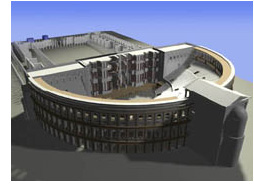 The dazzling scene, crowded
with early morning shoppers
and stands selling everything
imaginable, had appeared
literally overnight in what had
been a relatively empty square.
The smells, the shouts, the
color all combined to make a
tapestry of human life that
instantly knit me in and
welcomed me as a resident.
I explored everynook and
cranny, making a big circle through the piazza and returning where I had started near the gypsy stands that sat in the least desirable part of the market behind the fish stalls. Still wearing the slippers, I noticed a cart with used shoes. There were my shoes neatly tied together with a 200 lire tag attached. 200 lire poorer, I headed upstairs to eat my breakfast of fresh eggs, prosciutto and bread on the terrace overlooking the thieves, the beggars, the merchants and the residents of the oldest, continuously populated area of Rome. The dazzling scene, crowded
with early morning shoppers
and stands selling everything
imaginable, had appeared
literally overnight in what had
been a relatively empty square.
The smells, the shouts, the
color all combined to make a
tapestry of human life that
instantly knit me in and
welcomed me as a resident.
I explored everynook and
cranny, making a big circle through the piazza and returning where I had started near the gypsy stands that sat in the least desirable part of the market behind the fish stalls. Still wearing the slippers, I noticed a cart with used shoes. There were my shoes neatly tied together with a 200 lire tag attached. 200 lire poorer, I headed upstairs to eat my breakfast of fresh eggs, prosciutto and bread on the terrace overlooking the thieves, the beggars, the merchants and the residents of the oldest, continuously populated area of Rome.
Over the next nine months, I spent virtually every day studying the
history, the architecture, the traffic and the uses of this amazing urban space. Campo dei Fiori became the subject of my thesis, and what I learned has relevance for developers, community officials and retailers interested in capturing a vibrant experience in a shopping environment.
The Components of Experience.
I discovered eight qualities that make Campo dei Fiori such a great model for successful commercial spaces. These qualities are scale, texture, circulation and access, mixed use, change, display, history, and, most importantly, people. While the expression of these qualities are specific to Campo dei Fiori, virtually any new development can be designed to allow these things to take root, to evolve naturally and to sustain a lively sense of community. And while these qualities are not design solutions in themselves, they should be counted among the things that inform design decisions.
1. Scale
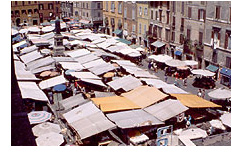 Humans, like other animals, have
an inherent sense of comfortable
scale. Too small and we feel
cramped or even trapped. Too
large and we feel exposed and
vulnerable. Too uniform and we
feel a lack of stimulation. Too
complex or spread out and we
feel a lack place. These feelings
cannot be translated into specific widths and heights, as this is a sliding scale. Nevertheless, lay people as well as architects know when a space works. Campo dei Fiori works because the shape is like a shoebox. For people, this is a pleasing shape because we can detect the boundaries. The height gives a sense of enclosure without being oppressive. At Campo dei Fiori, the buildings are mostly five stories, which allow us to easily see people and details on the upper levels. The open sky is large enough to give us a real vista, like walking out of a dense forest into a large open glen. There are also many openings onto adjacent streets and courtyards that give our eye some complexity and our imagination some intrigue. We can see similar examples of effective scale at Union Square in Manhattan and at The Third Street Promenade in Santa Monica. Most malls, even those with multi-story atriums, fail when it comes to effective scale. This suggests why many of us feel uneasy in large enclosed shopping centers. The scale does not trigger the right comfort cues in our brain. Humans, like other animals, have
an inherent sense of comfortable
scale. Too small and we feel
cramped or even trapped. Too
large and we feel exposed and
vulnerable. Too uniform and we
feel a lack of stimulation. Too
complex or spread out and we
feel a lack place. These feelings
cannot be translated into specific widths and heights, as this is a sliding scale. Nevertheless, lay people as well as architects know when a space works. Campo dei Fiori works because the shape is like a shoebox. For people, this is a pleasing shape because we can detect the boundaries. The height gives a sense of enclosure without being oppressive. At Campo dei Fiori, the buildings are mostly five stories, which allow us to easily see people and details on the upper levels. The open sky is large enough to give us a real vista, like walking out of a dense forest into a large open glen. There are also many openings onto adjacent streets and courtyards that give our eye some complexity and our imagination some intrigue. We can see similar examples of effective scale at Union Square in Manhattan and at The Third Street Promenade in Santa Monica. Most malls, even those with multi-story atriums, fail when it comes to effective scale. This suggests why many of us feel uneasy in large enclosed shopping centers. The scale does not trigger the right comfort cues in our brain.
2. Texture
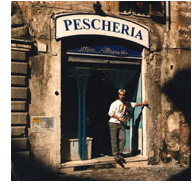 Closely related to scale is texture, and I'm
not talking about mixing a little ochre stucco
with some fake brick. At Campo dei Fiori,
there are the cobbled streets, the richly
hued facades, overhanging balconies, a
marble fountain and an ominous statue of
Giordano Bruno that serves both as land-
mark and meeting place. There are also the
inscribed stone plaques, uniquely orna-
mented fenestration, awnings of different
designs, signs that didn't spring from an
identity manual, complex masonry patterns and the wear marks that suggest we are not the only ones who have been here. The smells, the graffiti and even the trash add to the texture and a positive overall feeling. In this texture we feel the presence of our fellow citizens - living and dead. That sense, that many people made their personal history here, is totally missing in most commercial shopping centers. Contemporary malls do not reveal the hand of our fellow man. Failure to provide the texture that communicates human expression, with all its quirks and illogic, eliminates one eighth of the formula for producing a rewarding experience. Closely related to scale is texture, and I'm
not talking about mixing a little ochre stucco
with some fake brick. At Campo dei Fiori,
there are the cobbled streets, the richly
hued facades, overhanging balconies, a
marble fountain and an ominous statue of
Giordano Bruno that serves both as land-
mark and meeting place. There are also the
inscribed stone plaques, uniquely orna-
mented fenestration, awnings of different
designs, signs that didn't spring from an
identity manual, complex masonry patterns and the wear marks that suggest we are not the only ones who have been here. The smells, the graffiti and even the trash add to the texture and a positive overall feeling. In this texture we feel the presence of our fellow citizens - living and dead. That sense, that many people made their personal history here, is totally missing in most commercial shopping centers. Contemporary malls do not reveal the hand of our fellow man. Failure to provide the texture that communicates human expression, with all its quirks and illogic, eliminates one eighth of the formula for producing a rewarding experience.
3. Circulation and Access
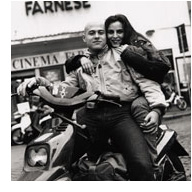 Movement is at the root of our ancient
brain. For defensive reasons, we are always
on the lookout for it. If movement in public
spaces lacks complexity, we soon grow
bored. That's why the movement of people
and vehicles are so important to Campo
dei Fiori. Pedestrians, scooters, carts and
motorized delivery vehicles compete with
cars and taxis on the racetrack-like ring
road that circles the piazza. Entry points
are at each corner and at third points down the length. The tempo and composition of this traffic changes throughout the day. In these ebbs and flows is a complex circulation that would appear as an oval dissected by paths and punctuated by rest points. Round and round, zipping in and out, with a pause.
It's as though the traffic was choreographed by a composer. This musical circulation is also critical to the sense of experience. One way to create good circulation is to open retail areas to a variety of traffic including those on foot and those in vehicles. Property owners may control traffic pattern, but it should not
be limited to a single type of traffic. In fact, efforts should be made to create
clear and accessible thoroughfares that punch through privately held spaces where possible. Movement is at the root of our ancient
brain. For defensive reasons, we are always
on the lookout for it. If movement in public
spaces lacks complexity, we soon grow
bored. That's why the movement of people
and vehicles are so important to Campo
dei Fiori. Pedestrians, scooters, carts and
motorized delivery vehicles compete with
cars and taxis on the racetrack-like ring
road that circles the piazza. Entry points
are at each corner and at third points down the length. The tempo and composition of this traffic changes throughout the day. In these ebbs and flows is a complex circulation that would appear as an oval dissected by paths and punctuated by rest points. Round and round, zipping in and out, with a pause.
It's as though the traffic was choreographed by a composer. This musical circulation is also critical to the sense of experience. One way to create good circulation is to open retail areas to a variety of traffic including those on foot and those in vehicles. Property owners may control traffic pattern, but it should not
be limited to a single type of traffic. In fact, efforts should be made to create
clear and accessible thoroughfares that punch through privately held spaces where possible.
4. Mixed Use
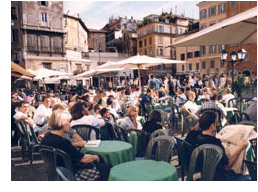 Spaces must have many
users in order to produce a
rich experience. At Campo
dei Fiori we have use by
many groups for different
purposes. Mixed use tran-
slates into hotels, offices and
private residences sitting
side-by-side on the upper
floors. It means a school on
the corner andrestaurants
cheek by jowl with shops. It means beggars, street musicians and hawkers of sports souvenirs competing with the grocer, the tailor and the candlestick maker. Mixed use means a political rally, a religious observance, parades, commerce, dining, play and the afternoon passeggiatta. It also says it's OK to just come here and watch the human parade. The minute we try to edit these uses, we sterilize the experience. We are the poorer for it. Spaces must have many
users in order to produce a
rich experience. At Campo
dei Fiori we have use by
many groups for different
purposes. Mixed use tran-
slates into hotels, offices and
private residences sitting
side-by-side on the upper
floors. It means a school on
the corner andrestaurants
cheek by jowl with shops. It means beggars, street musicians and hawkers of sports souvenirs competing with the grocer, the tailor and the candlestick maker. Mixed use means a political rally, a religious observance, parades, commerce, dining, play and the afternoon passeggiatta. It also says it's OK to just come here and watch the human parade. The minute we try to edit these uses, we sterilize the experience. We are the poorer for it.
5. Change
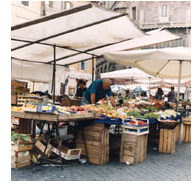 Even the best experience must change
over time. It may be over the day, over the
week or from season to season. At Campo
dei Fiori, activities change constantly. Some
are regular and predictable. Others are
spontaneous. For instance, the open-air
market is a morning affair just five hours
long, after which the place is transformed
into a complex of sidewalk restaurants and
cafes serving lunch. In the later afternoon,
it becomes a promenade with shop owners
taking front stage. This is about the same time that school lets out and the center of the piazza fills with children kicking soccer balls and playing tag. Later, the restaurants reappear with a more elegant presentation including tableside serenades. The movie theater opens, and the wine bars fill. As the adults begin to retreat, teens take over, branding the place with their ever-changing definition of what's cool. And in the darkest hours of the night, the whores, the homeless and the workers who set up the next morning's market take over the grave shift. The rhythm of the space is like acts in a play. It produces an experience with a rich cast of characters and dozens of set changes. Even the best experience must change
over time. It may be over the day, over the
week or from season to season. At Campo
dei Fiori, activities change constantly. Some
are regular and predictable. Others are
spontaneous. For instance, the open-air
market is a morning affair just five hours
long, after which the place is transformed
into a complex of sidewalk restaurants and
cafes serving lunch. In the later afternoon,
it becomes a promenade with shop owners
taking front stage. This is about the same time that school lets out and the center of the piazza fills with children kicking soccer balls and playing tag. Later, the restaurants reappear with a more elegant presentation including tableside serenades. The movie theater opens, and the wine bars fill. As the adults begin to retreat, teens take over, branding the place with their ever-changing definition of what's cool. And in the darkest hours of the night, the whores, the homeless and the workers who set up the next morning's market take over the grave shift. The rhythm of the space is like acts in a play. It produces an experience with a rich cast of characters and dozens of set changes.
6. Display
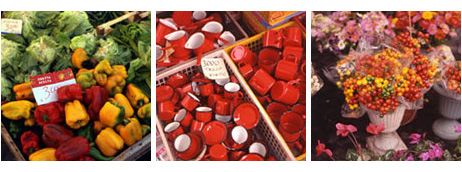
Display is personal expression harnessed to make things sell. Display is signage, window dressing, product arrangement, costumes, smell, music and the personalities of the merchants to name just a few. One of the more remarkable aspects of display in Campo dei Fiori is found in the demountable market stalls that are erected around 4am and dismantled around noon. In addition to providing for weather, security and storage, these stalls provide excellent display for all kinds of merchandise. The fact that all these wares are so visible and enticing elevates the sense of excitement and sets off a kind of feeding frenzy. A visitor just can't walk away without having purchased an armful of things. In contrast, most malls provide a corporately designed and somewhat over-thought shopping experience. A better retail experience should attempt to dial up the chaos in display.
7. History
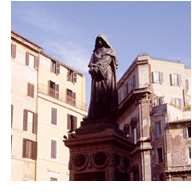 How can you make history in a brand new
development? The answer is that history
happened and history will happen. We
build on the foundation of what was
supplied, and we add to it over time.
Campo dei Fiori is, quite frankly, not what
it was thirty years ago when I was in
college. The market is half the size, the
wonderful sail awnings have been replaced
by more standard umbrellas, and the
merchant mix has become slicker reflecting
the wealthier classes that have moved into this previously poor neighborhood. But this is part of the history that began with merchants hawking things to theatergoers 2,000 years ago. Each decade brought new history, and each decade in the future will add more. This is why developers and civic authorities should ground their projects in things that are indigenous to the area and its people. Great care should be taken to avoid trendy or purely decorative solutions that produce a Disneyland. Developers should also allow for change and the addition of new ideas by not locking their developments into rigid themes or guidelines. The result will be a more sustainable experience that doesn't lose its luster over time and is more difficult for competing centers to knock off. How can you make history in a brand new
development? The answer is that history
happened and history will happen. We
build on the foundation of what was
supplied, and we add to it over time.
Campo dei Fiori is, quite frankly, not what
it was thirty years ago when I was in
college. The market is half the size, the
wonderful sail awnings have been replaced
by more standard umbrellas, and the
merchant mix has become slicker reflecting
the wealthier classes that have moved into this previously poor neighborhood. But this is part of the history that began with merchants hawking things to theatergoers 2,000 years ago. Each decade brought new history, and each decade in the future will add more. This is why developers and civic authorities should ground their projects in things that are indigenous to the area and its people. Great care should be taken to avoid trendy or purely decorative solutions that produce a Disneyland. Developers should also allow for change and the addition of new ideas by not locking their developments into rigid themes or guidelines. The result will be a more sustainable experience that doesn't lose its luster over time and is more difficult for competing centers to knock off.
8. People
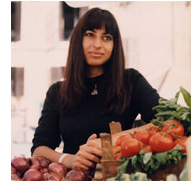 People are the most important ingredient
by far. As social beings, we are drawn to
crowds. In our modern, more isolated lives,
we tend to move from private residence,
via sealed capsule, to work where we run
into the same people every day. When we
step out into the public, at a ball game, or
at a shopping center, or at an airport, we
come into contact with hundreds of
strangers. These are people we cannot
edit or control. And this is what makes it
interesting. We check out the folks around us. The more diverse this crowd, the richer the experience. At Campo dei Fiori, the crowds come from every walk of life. There are residents and tourists, merchants and thieves, musicians and lotto salesmen, the gentrified elite and the working class Communist, the very, very young and the very, very old, the educated and the illiterate. The sea of Roman humanity passes through this piazza everyday, and every class is represented. No one stands at the entrance and selects who should enter. The tenant mix is broad enough and the right-of-way is free enough to produce a good social mixer. In truth, the daily outdoor market helps a great deal. Outdoor markets are great levelers for society. Therefore, the attempts to rebuild or manufacture 'main streets' in this country should seriously look at involving local farmers in the tenant mix. For other shopping centers, the key is to encourage everyone to come. Even the gypsies who stole my shoes added to my experience at Campo dei Fiori. People are the most important ingredient
by far. As social beings, we are drawn to
crowds. In our modern, more isolated lives,
we tend to move from private residence,
via sealed capsule, to work where we run
into the same people every day. When we
step out into the public, at a ball game, or
at a shopping center, or at an airport, we
come into contact with hundreds of
strangers. These are people we cannot
edit or control. And this is what makes it
interesting. We check out the folks around us. The more diverse this crowd, the richer the experience. At Campo dei Fiori, the crowds come from every walk of life. There are residents and tourists, merchants and thieves, musicians and lotto salesmen, the gentrified elite and the working class Communist, the very, very young and the very, very old, the educated and the illiterate. The sea of Roman humanity passes through this piazza everyday, and every class is represented. No one stands at the entrance and selects who should enter. The tenant mix is broad enough and the right-of-way is free enough to produce a good social mixer. In truth, the daily outdoor market helps a great deal. Outdoor markets are great levelers for society. Therefore, the attempts to rebuild or manufacture 'main streets' in this country should seriously look at involving local farmers in the tenant mix. For other shopping centers, the key is to encourage everyone to come. Even the gypsies who stole my shoes added to my experience at Campo dei Fiori.
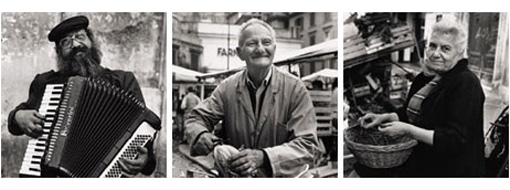
Influencing Modern Shopping Center Design.
This article has focused on the qualities that can contribute to an authentic, exciting and sustainable experience at shopping centers and malls. And while there are obvious differences between public commercial areas with their numerous property owners and malls that are owned and operated by a single entity, the lessons of Campo dei Fiori can inform the design of more profitable and rewarding facilities. The creation of "Main Streets" is an important step in the right direction, but more can be done to blur the boundaries between public and private spaces, to reduce Disneyfication and to celebrate the history, values and personality of our unique communities.
In some respects it's sad that we even have to discuss this. All of the qualities explained here exist or have existed in our cities and towns. It's only been over the last fifty years with the advent of suburbs, freeways and mass distribution that the monotone mall has replaced Main Street and the town square. While these malls have been wonders of efficiency, they lack heart. That's why they get torn down when a new, bigger mall opens down the road. It's also why we feel hustled. We are aware that the retailers want us to purchase quickly to keep their return per square foot high. And because these malls are driven by profit, the management companies' primary concern has been the creation of an optimized tenant mix with little overlap. Missing is the bare knuckles competition one sees on the street. Also missing are things that do not directly contribute to mall profit, like musicians and palm readers for instance.
So now that there are new and more efficient ways to buy things, developers and shopping center operators have been forced to pay attention to the qualities of a positive experience that have existed all along in public spaces, that have existed quite successfully for over 2,000 years at Campo dei Fiori.
Principal photography: John Colao. Additional photography: Rick Seireeni.
Updated from an essay written in 2004.
© Rick Seireeni, Brand Architect and President
The Brand Architect Group, Los Angeles.
Permission to reprint all or portions of this text subject to written approval.
The Brand Architect Group is a strategic brand consultancy with offices in Los Angeles, Tokyo and Shanghai. Project specialties include retail, food service, banking and real estate development.
www.brandarchitect.com

|
 |
About Richard Seireeni
Articles by Richard Seireeni:

Executive Compensation and Corporate Social Responsibility

Wall Street vs. Green Street:
Who is Doing Better?

The Short, Sweet Life of the
Japanese-Home.

Japanese Gas Companies Compete for a Piece of
the Electric Pie

Asia and The Age of Sustainability:
Where The East Has an Edge.

ThinkPark Commercial High-Rise:
Tokyo's First Step Toward Green Urbanism

How Women Are Shaping The Market For Sustainable Products:
An Example of Gender Power in Japan

Building a Retail Experience:
Lessons from a 2,000 Year-Old Marketplace

Greening Our Home: Reducing Our Carbon Footprint Step By Step

Suggested Reading

|
|

![]()

 One of the more popular
solutions is the 'Main Street'
model, where the designs
echo romanticized town
squares. A recent example is
The Grove in Los Angeles, a
project that captures a small
town feel with a Disneyesque
execution. While efforts like
tthese are a step in the right
direction away from herme-
tically sealed malls, some of
these 'Main Streets' still have an artificial, sterile feel. Because most are designed and built all at once, they lack the sense of history that a naturally evolving community center has. Because the spaces tend to be 'secure', we don't see a lot of street people, itinerant craftsmen or freelance musicians. Because the developer 'edits' the experience, the result can be one-dimensional. The unbridled penchant to be 'messy' humans is gone. In the worst cases, it produces a prophylactic environment that fails to give us that full hit of the 'human experience' we crave as social animals. So how should property owners, developers and communities create viable and sustainable retail experiences?
One of the more popular
solutions is the 'Main Street'
model, where the designs
echo romanticized town
squares. A recent example is
The Grove in Los Angeles, a
project that captures a small
town feel with a Disneyesque
execution. While efforts like
tthese are a step in the right
direction away from herme-
tically sealed malls, some of
these 'Main Streets' still have an artificial, sterile feel. Because most are designed and built all at once, they lack the sense of history that a naturally evolving community center has. Because the spaces tend to be 'secure', we don't see a lot of street people, itinerant craftsmen or freelance musicians. Because the developer 'edits' the experience, the result can be one-dimensional. The unbridled penchant to be 'messy' humans is gone. In the worst cases, it produces a prophylactic environment that fails to give us that full hit of the 'human experience' we crave as social animals. So how should property owners, developers and communities create viable and sustainable retail experiences?  To start, I think it's important
to look at real thing - the real
Main Streets that large
property owners seek to
emulate. The Santa Monica
Third Street Promenade and
Seattle's Pike Place Market
are two that come to mind.
Both evolved naturally with
their diversity having been
preserved by a coalition of
property owners and local
government. The older buildings clash with the new in a pleasing jumble that gives us a sense of history. Cars, delivery vehicles, trash and smells that are a normal part of the urban commercial experience are not edited out of the picture. The mix of small shops, stands, street vendors and the nearby department stores all lend to a wonderful mish-mash of personal and corporate expression. And most importantly, there is no gatekeeper allowing certain people in and keeping certain people out. So long as the laws of civility are obeyed, all are welcome, and they all come. The suburban family in their Cadillac Escalade rubs shoulders with the homeless guy who just emerged from his appliance box home. Sure, there's the occasional fly in the soup, but the experience is rich and exciting. I like a little theater with my commerce, a preference I developed while studying a 2,000 year-old marketplace in Rome.
To start, I think it's important
to look at real thing - the real
Main Streets that large
property owners seek to
emulate. The Santa Monica
Third Street Promenade and
Seattle's Pike Place Market
are two that come to mind.
Both evolved naturally with
their diversity having been
preserved by a coalition of
property owners and local
government. The older buildings clash with the new in a pleasing jumble that gives us a sense of history. Cars, delivery vehicles, trash and smells that are a normal part of the urban commercial experience are not edited out of the picture. The mix of small shops, stands, street vendors and the nearby department stores all lend to a wonderful mish-mash of personal and corporate expression. And most importantly, there is no gatekeeper allowing certain people in and keeping certain people out. So long as the laws of civility are obeyed, all are welcome, and they all come. The suburban family in their Cadillac Escalade rubs shoulders with the homeless guy who just emerged from his appliance box home. Sure, there's the occasional fly in the soup, but the experience is rich and exciting. I like a little theater with my commerce, a preference I developed while studying a 2,000 year-old marketplace in Rome. I arrived in Rome on a bright spring morning
in 1973. It was the beginning of my Rome
Studies Program sponsored by the
University of Washington School of
Architecture. And while I had lived in
Europe before, it was a big change for a
person raised in the suburbs of Seattle, like
me. So it was a further surprise to be
quartered in a wonderful little apartment
overlooking one of the most vibrant and
exciting urban spaces in the world. This
space is the piazza Campo dei Fiori, an
urban stage that traces its heritage back
to the time of Republican Rome. One of
the many nuggets of information* is that
this is the site of Julius Caesar's murder in 44 BCE. He was knifed in a small building adjoining the Theater of Pompey, an imposing structure that first established this area in the urban framework of Rome. That first day was a full one for me. Connecting with my fellow students and my Professoressa. Exploring the neighborhood. Getting a tour of my building and learning the house rules, one of which was to leave your shoes outside the front door at least once a week. This was so the old woman who lived on the ground floor could clean them, giving her a sense of usefulness and a little pocket money. As my only pair of college kid shoes were a little banged up, I left them outside the door on my first night. In the morning they were gone.
I arrived in Rome on a bright spring morning
in 1973. It was the beginning of my Rome
Studies Program sponsored by the
University of Washington School of
Architecture. And while I had lived in
Europe before, it was a big change for a
person raised in the suburbs of Seattle, like
me. So it was a further surprise to be
quartered in a wonderful little apartment
overlooking one of the most vibrant and
exciting urban spaces in the world. This
space is the piazza Campo dei Fiori, an
urban stage that traces its heritage back
to the time of Republican Rome. One of
the many nuggets of information* is that
this is the site of Julius Caesar's murder in 44 BCE. He was knifed in a small building adjoining the Theater of Pompey, an imposing structure that first established this area in the urban framework of Rome. That first day was a full one for me. Connecting with my fellow students and my Professoressa. Exploring the neighborhood. Getting a tour of my building and learning the house rules, one of which was to leave your shoes outside the front door at least once a week. This was so the old woman who lived on the ground floor could clean them, giving her a sense of usefulness and a little pocket money. As my only pair of college kid shoes were a little banged up, I left them outside the door on my first night. In the morning they were gone. The dazzling scene, crowded
with early morning shoppers
and stands selling everything
imaginable, had appeared
literally overnight in what had
been a relatively empty square.
The smells, the shouts, the
color all combined to make a
tapestry of human life that
instantly knit me in and
welcomed me as a resident.
I explored everynook and
cranny, making a big circle through the piazza and returning where I had started near the gypsy stands that sat in the least desirable part of the market behind the fish stalls. Still wearing the slippers, I noticed a cart with used shoes. There were my shoes neatly tied together with a 200 lire tag attached. 200 lire poorer, I headed upstairs to eat my breakfast of fresh eggs, prosciutto and bread on the terrace overlooking the thieves, the beggars, the merchants and the residents of the oldest, continuously populated area of Rome.
The dazzling scene, crowded
with early morning shoppers
and stands selling everything
imaginable, had appeared
literally overnight in what had
been a relatively empty square.
The smells, the shouts, the
color all combined to make a
tapestry of human life that
instantly knit me in and
welcomed me as a resident.
I explored everynook and
cranny, making a big circle through the piazza and returning where I had started near the gypsy stands that sat in the least desirable part of the market behind the fish stalls. Still wearing the slippers, I noticed a cart with used shoes. There were my shoes neatly tied together with a 200 lire tag attached. 200 lire poorer, I headed upstairs to eat my breakfast of fresh eggs, prosciutto and bread on the terrace overlooking the thieves, the beggars, the merchants and the residents of the oldest, continuously populated area of Rome. Humans, like other animals, have
an inherent sense of comfortable
scale. Too small and we feel
cramped or even trapped. Too
large and we feel exposed and
vulnerable. Too uniform and we
feel a lack of stimulation. Too
complex or spread out and we
feel a lack place. These feelings
cannot be translated into specific widths and heights, as this is a sliding scale. Nevertheless, lay people as well as architects know when a space works. Campo dei Fiori works because the shape is like a shoebox. For people, this is a pleasing shape because we can detect the boundaries. The height gives a sense of enclosure without being oppressive. At Campo dei Fiori, the buildings are mostly five stories, which allow us to easily see people and details on the upper levels. The open sky is large enough to give us a real vista, like walking out of a dense forest into a large open glen. There are also many openings onto adjacent streets and courtyards that give our eye some complexity and our imagination some intrigue. We can see similar examples of effective scale at Union Square in Manhattan and at The Third Street Promenade in Santa Monica. Most malls, even those with multi-story atriums, fail when it comes to effective scale. This suggests why many of us feel uneasy in large enclosed shopping centers. The scale does not trigger the right comfort cues in our brain.
Humans, like other animals, have
an inherent sense of comfortable
scale. Too small and we feel
cramped or even trapped. Too
large and we feel exposed and
vulnerable. Too uniform and we
feel a lack of stimulation. Too
complex or spread out and we
feel a lack place. These feelings
cannot be translated into specific widths and heights, as this is a sliding scale. Nevertheless, lay people as well as architects know when a space works. Campo dei Fiori works because the shape is like a shoebox. For people, this is a pleasing shape because we can detect the boundaries. The height gives a sense of enclosure without being oppressive. At Campo dei Fiori, the buildings are mostly five stories, which allow us to easily see people and details on the upper levels. The open sky is large enough to give us a real vista, like walking out of a dense forest into a large open glen. There are also many openings onto adjacent streets and courtyards that give our eye some complexity and our imagination some intrigue. We can see similar examples of effective scale at Union Square in Manhattan and at The Third Street Promenade in Santa Monica. Most malls, even those with multi-story atriums, fail when it comes to effective scale. This suggests why many of us feel uneasy in large enclosed shopping centers. The scale does not trigger the right comfort cues in our brain. Closely related to scale is texture, and I'm
not talking about mixing a little ochre stucco
with some fake brick. At Campo dei Fiori,
there are the cobbled streets, the richly
hued facades, overhanging balconies, a
marble fountain and an ominous statue of
Giordano Bruno that serves both as land-
mark and meeting place. There are also the
inscribed stone plaques, uniquely orna-
mented fenestration, awnings of different
designs, signs that didn't spring from an
identity manual, complex masonry patterns and the wear marks that suggest we are not the only ones who have been here. The smells, the graffiti and even the trash add to the texture and a positive overall feeling. In this texture we feel the presence of our fellow citizens - living and dead. That sense, that many people made their personal history here, is totally missing in most commercial shopping centers. Contemporary malls do not reveal the hand of our fellow man. Failure to provide the texture that communicates human expression, with all its quirks and illogic, eliminates one eighth of the formula for producing a rewarding experience.
Closely related to scale is texture, and I'm
not talking about mixing a little ochre stucco
with some fake brick. At Campo dei Fiori,
there are the cobbled streets, the richly
hued facades, overhanging balconies, a
marble fountain and an ominous statue of
Giordano Bruno that serves both as land-
mark and meeting place. There are also the
inscribed stone plaques, uniquely orna-
mented fenestration, awnings of different
designs, signs that didn't spring from an
identity manual, complex masonry patterns and the wear marks that suggest we are not the only ones who have been here. The smells, the graffiti and even the trash add to the texture and a positive overall feeling. In this texture we feel the presence of our fellow citizens - living and dead. That sense, that many people made their personal history here, is totally missing in most commercial shopping centers. Contemporary malls do not reveal the hand of our fellow man. Failure to provide the texture that communicates human expression, with all its quirks and illogic, eliminates one eighth of the formula for producing a rewarding experience. Movement is at the root of our ancient
brain. For defensive reasons, we are always
on the lookout for it. If movement in public
spaces lacks complexity, we soon grow
bored. That's why the movement of people
and vehicles are so important to Campo
dei Fiori. Pedestrians, scooters, carts and
motorized delivery vehicles compete with
cars and taxis on the racetrack-like ring
road that circles the piazza. Entry points
are at each corner and at third points down the length. The tempo and composition of this traffic changes throughout the day. In these ebbs and flows is a complex circulation that would appear as an oval dissected by paths and punctuated by rest points. Round and round, zipping in and out, with a pause.
It's as though the traffic was choreographed by a composer. This musical circulation is also critical to the sense of experience. One way to create good circulation is to open retail areas to a variety of traffic including those on foot and those in vehicles. Property owners may control traffic pattern, but it should not
be limited to a single type of traffic. In fact, efforts should be made to create
clear and accessible thoroughfares that punch through privately held spaces where possible.
Movement is at the root of our ancient
brain. For defensive reasons, we are always
on the lookout for it. If movement in public
spaces lacks complexity, we soon grow
bored. That's why the movement of people
and vehicles are so important to Campo
dei Fiori. Pedestrians, scooters, carts and
motorized delivery vehicles compete with
cars and taxis on the racetrack-like ring
road that circles the piazza. Entry points
are at each corner and at third points down the length. The tempo and composition of this traffic changes throughout the day. In these ebbs and flows is a complex circulation that would appear as an oval dissected by paths and punctuated by rest points. Round and round, zipping in and out, with a pause.
It's as though the traffic was choreographed by a composer. This musical circulation is also critical to the sense of experience. One way to create good circulation is to open retail areas to a variety of traffic including those on foot and those in vehicles. Property owners may control traffic pattern, but it should not
be limited to a single type of traffic. In fact, efforts should be made to create
clear and accessible thoroughfares that punch through privately held spaces where possible. Spaces must have many
users in order to produce a
rich experience. At Campo
dei Fiori we have use by
many groups for different
purposes. Mixed use tran-
slates into hotels, offices and
private residences sitting
side-by-side on the upper
floors. It means a school on
the corner andrestaurants
cheek by jowl with shops. It means beggars, street musicians and hawkers of sports souvenirs competing with the grocer, the tailor and the candlestick maker. Mixed use means a political rally, a religious observance, parades, commerce, dining, play and the afternoon passeggiatta. It also says it's OK to just come here and watch the human parade. The minute we try to edit these uses, we sterilize the experience. We are the poorer for it.
Spaces must have many
users in order to produce a
rich experience. At Campo
dei Fiori we have use by
many groups for different
purposes. Mixed use tran-
slates into hotels, offices and
private residences sitting
side-by-side on the upper
floors. It means a school on
the corner andrestaurants
cheek by jowl with shops. It means beggars, street musicians and hawkers of sports souvenirs competing with the grocer, the tailor and the candlestick maker. Mixed use means a political rally, a religious observance, parades, commerce, dining, play and the afternoon passeggiatta. It also says it's OK to just come here and watch the human parade. The minute we try to edit these uses, we sterilize the experience. We are the poorer for it. Even the best experience must change
over time. It may be over the day, over the
week or from season to season. At Campo
dei Fiori, activities change constantly. Some
are regular and predictable. Others are
spontaneous. For instance, the open-air
market is a morning affair just five hours
long, after which the place is transformed
into a complex of sidewalk restaurants and
cafes serving lunch. In the later afternoon,
it becomes a promenade with shop owners
taking front stage. This is about the same time that school lets out and the center of the piazza fills with children kicking soccer balls and playing tag. Later, the restaurants reappear with a more elegant presentation including tableside serenades. The movie theater opens, and the wine bars fill. As the adults begin to retreat, teens take over, branding the place with their ever-changing definition of what's cool. And in the darkest hours of the night, the whores, the homeless and the workers who set up the next morning's market take over the grave shift. The rhythm of the space is like acts in a play. It produces an experience with a rich cast of characters and dozens of set changes.
Even the best experience must change
over time. It may be over the day, over the
week or from season to season. At Campo
dei Fiori, activities change constantly. Some
are regular and predictable. Others are
spontaneous. For instance, the open-air
market is a morning affair just five hours
long, after which the place is transformed
into a complex of sidewalk restaurants and
cafes serving lunch. In the later afternoon,
it becomes a promenade with shop owners
taking front stage. This is about the same time that school lets out and the center of the piazza fills with children kicking soccer balls and playing tag. Later, the restaurants reappear with a more elegant presentation including tableside serenades. The movie theater opens, and the wine bars fill. As the adults begin to retreat, teens take over, branding the place with their ever-changing definition of what's cool. And in the darkest hours of the night, the whores, the homeless and the workers who set up the next morning's market take over the grave shift. The rhythm of the space is like acts in a play. It produces an experience with a rich cast of characters and dozens of set changes.
 How can you make history in a brand new
development? The answer is that history
happened and history will happen. We
build on the foundation of what was
supplied, and we add to it over time.
Campo dei Fiori is, quite frankly, not what
it was thirty years ago when I was in
college. The market is half the size, the
wonderful sail awnings have been replaced
by more standard umbrellas, and the
merchant mix has become slicker reflecting
the wealthier classes that have moved into this previously poor neighborhood. But this is part of the history that began with merchants hawking things to theatergoers 2,000 years ago. Each decade brought new history, and each decade in the future will add more. This is why developers and civic authorities should ground their projects in things that are indigenous to the area and its people. Great care should be taken to avoid trendy or purely decorative solutions that produce a Disneyland. Developers should also allow for change and the addition of new ideas by not locking their developments into rigid themes or guidelines. The result will be a more sustainable experience that doesn't lose its luster over time and is more difficult for competing centers to knock off.
How can you make history in a brand new
development? The answer is that history
happened and history will happen. We
build on the foundation of what was
supplied, and we add to it over time.
Campo dei Fiori is, quite frankly, not what
it was thirty years ago when I was in
college. The market is half the size, the
wonderful sail awnings have been replaced
by more standard umbrellas, and the
merchant mix has become slicker reflecting
the wealthier classes that have moved into this previously poor neighborhood. But this is part of the history that began with merchants hawking things to theatergoers 2,000 years ago. Each decade brought new history, and each decade in the future will add more. This is why developers and civic authorities should ground their projects in things that are indigenous to the area and its people. Great care should be taken to avoid trendy or purely decorative solutions that produce a Disneyland. Developers should also allow for change and the addition of new ideas by not locking their developments into rigid themes or guidelines. The result will be a more sustainable experience that doesn't lose its luster over time and is more difficult for competing centers to knock off. People are the most important ingredient
by far. As social beings, we are drawn to
crowds. In our modern, more isolated lives,
we tend to move from private residence,
via sealed capsule, to work where we run
into the same people every day. When we
step out into the public, at a ball game, or
at a shopping center, or at an airport, we
come into contact with hundreds of
strangers. These are people we cannot
edit or control. And this is what makes it
interesting. We check out the folks around us. The more diverse this crowd, the richer the experience. At Campo dei Fiori, the crowds come from every walk of life. There are residents and tourists, merchants and thieves, musicians and lotto salesmen, the gentrified elite and the working class Communist, the very, very young and the very, very old, the educated and the illiterate. The sea of Roman humanity passes through this piazza everyday, and every class is represented. No one stands at the entrance and selects who should enter. The tenant mix is broad enough and the right-of-way is free enough to produce a good social mixer. In truth, the daily outdoor market helps a great deal. Outdoor markets are great levelers for society. Therefore, the attempts to rebuild or manufacture 'main streets' in this country should seriously look at involving local farmers in the tenant mix. For other shopping centers, the key is to encourage everyone to come. Even the gypsies who stole my shoes added to my experience at Campo dei Fiori.
People are the most important ingredient
by far. As social beings, we are drawn to
crowds. In our modern, more isolated lives,
we tend to move from private residence,
via sealed capsule, to work where we run
into the same people every day. When we
step out into the public, at a ball game, or
at a shopping center, or at an airport, we
come into contact with hundreds of
strangers. These are people we cannot
edit or control. And this is what makes it
interesting. We check out the folks around us. The more diverse this crowd, the richer the experience. At Campo dei Fiori, the crowds come from every walk of life. There are residents and tourists, merchants and thieves, musicians and lotto salesmen, the gentrified elite and the working class Communist, the very, very young and the very, very old, the educated and the illiterate. The sea of Roman humanity passes through this piazza everyday, and every class is represented. No one stands at the entrance and selects who should enter. The tenant mix is broad enough and the right-of-way is free enough to produce a good social mixer. In truth, the daily outdoor market helps a great deal. Outdoor markets are great levelers for society. Therefore, the attempts to rebuild or manufacture 'main streets' in this country should seriously look at involving local farmers in the tenant mix. For other shopping centers, the key is to encourage everyone to come. Even the gypsies who stole my shoes added to my experience at Campo dei Fiori.